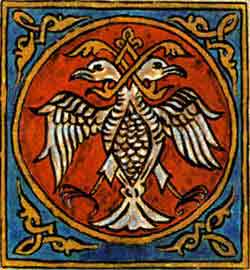

 |
 |
BATTLE OF KOSOVO
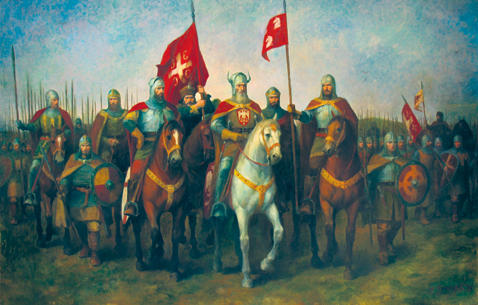
Battle of Kosovo
Of all Kosovo battles only one counts in the
formation of the psyche of a Serb. It is the one that began in the early hours
of Vidovdan (St. Vitus Day), June 15, 1389 (June 28 new calendar). The Turks had
already been on the European continent for some time, seemingly unstopable and
intoxicated by easy victories over the rival and disunited "infidels."
The battle of Kosovo took
place on the part of the Kosovo plain that the Turks called Mazgit, where the
rivulet Lab flows into the river Sitnica. Today's visitors learn where Sultan
Murad's intestines were buried, where the Turkish standard bearer (Gazimestan)
fell, where grateful Serbia erected a "Memorial to the fallen heroes of Kosovo,"
and where a marble column once stood (placed there on the order of, and authored
by, Prince Lazar's son, Despot Stefan Lazarevich), which had the following
inscription:
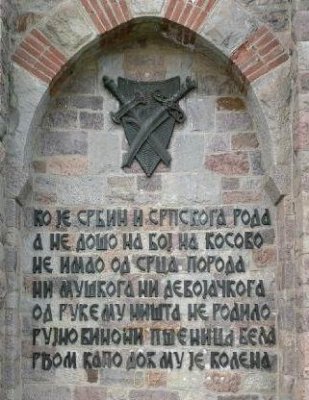
Gazimestan Monument
Oh man, stranger or hailing from this soil, when
you enter this Serbian land, whoever you may be ... when you come to this field
called Kosovo, you will see all over it plenty of bones of the dead, and with
them myself in stone nature, standing upright in the middle of the field,
representing both the cross and the flag. So as not to pass by and overlook me
as something unworthy and hollow, approach me, I beg you, oh my dear, and study
the words I bring to your attention, which will make you understand why I am
standing here...At this place there once was a great autocrat, a world wonder
and Serbian ruler by the name of Lazar, an unwavering tower of piety, a sea of
reason and depth of wisdom ... who loved everything that Christ wanted... He
accepted the sacrificial wreath of struggle and heavenly glory ... The daring
fighter was captured and the wrath of martyrdom he himself accepted ... the
great Prince Lazar... Everything said here took place in 1389... the fifteenth
day of June, Tuesday, at the sixth or seventh hour, I do not know exactly, God
knows.
Following World War II, a
redesigned monument was erected, a 25 meter tall tower, together with about 25
acres of the surrounding land, where the famous Kosovo peonies supposedly sprout
from the blood of the Kosovo heroes.
The Serbian army was
encamped along the right bank of the Lab, an area suitable for both infantry and
cavalry troops. The right wing of the Serbian army was under the command of
Vojvoda Dimitrije Vojinovich. The left wing stood under the command of Vojvoda
Vlatko Vukovich, sent by Bosnian King Tvrtko. Prince Lazar kept the command of
the center for himself. The reserve was under the command of Prince Lazar's
son-in-law, Vojvoda Vuk Brankovich.
Prince Lazar had many
reasons to worry about the outcome of the forthcoming encounter. Murad gave him
no time to rally his vassals and tributary lords, some of whom were
conspicuously slow in marshaling their troops. Lazar's frantic efforts to obtain
help from allies such as the king of Hungary, failed because it was difficult,
if not impossible, to organize it on such short notice. Nevertheless, although
ill-prepared, Lazar had no other choice but to face the enemy. Murad's advisers,
a group of extremely skilled military veterans, insisted on immediate and fast
action. Amassed in the area of today's Nish and Kumanovo, the Turkish generals
were eager to meet the Serbs while still possessing the momentum of previously
victorious campaigns.
Morale in the Serbian camp
was not high. Lazar's commanders were torn apart by local rivalries, ominous
jealousies, and distrust. Djuradj Stratimirovich-Balsha, prince of Zeta and
son-in-law of Lazar, and some vojvodas of the northern regions were delayed by
local "revolts" and opposition. Historians are still trying to ascertain whether
the revolts were real or simply used as excuses. Two other of Lazar's
sons-in-law, according to national tradition and accepted by some historians,
were bitterly divided, under the influence of their wives. According to
chroniclers, national bards, and traditional Kosovo saga, Vuk Brankovich of the
old aristocracy, who married Mara, and Milosh Obilich, of lesser birth, who
married Vukosava, fell prey to the ongoing feud between the two sisters. (Lazar's
geneological history, as presented by the historian Aleksa Ivich, however, does
not register Milosh Obilich among Lazar's sons-in-law.)
To make things worse,
several well-known and gallant Serbian and Bulgarian princes were at that time
already in the service of the Turkish conqueror, burdened by the obligations of
vassalage. Among them, Dragash and Konstantin ruled in the area between Serres
and Kustendil, while the sons of the late King Vukashin, Marko and Andrias,
ruled as vassals in the regions of today's western Macedonia. One should keep in
mind that at that time feudal mores required the vassal to serve his lord and
not his people.
Prince Lazar could have
taken some moral comfort from the fact that he and his people were defenders of
Christian civilization, and that the forthcoming battle would probably be the
last chance for Balkan Christians to repulse the Moslems. Some historians will
dispute it, but there are others who maintain that quite a few among the leaders
in the neighboring states--from Bulgaria, the Danubian lands, and even from the
area of today's Croatia--took part in the battle. It is indisuptable, however,
that among those who joined the Serbs were some Albanian princes. Even though no
Albanian state had yet existed, Albanian tribes were close allies of the Serbs,
and friendly relations between Serbian and Albanian chieftains were the natural
result of their common desire to get rid of, first the Byzantine and then the
Turkish oppressors. John Castriota (of Serbian origin), the father of the most
prominent Albanian, Skanderbeg, came to Kosovo at the head of a combined
Serbian-Albanian force mobilized in the area of Debar. Among auxiliary troops
were the volunteers led by Palatine Nicolas Gara (Gorjanski), another one of
Lazar's sons-in-law.
From the time that the
Serbian notables and church dignitaries met in the city of Skopia (Skoplje),
after the fatal battle in which King Vukashin and his army perished (Maritsa,
1371), and chose Lazar Hrebeljanovich as their leader, he enjoyed great
popularity and respect. In addition to his personal qualities, he was also the
husband of Militsa, the great granddaughter of Stefan Nemanja, the founder of
the Nemanjich dynasty. He therefore had some hereditary right to the throne of
Serbia. Wise, charitable, well-cultured, and skillful soldier, he defeated the
Turks in encounters that took place in 1381 and 1386, but it was becoming ever
more evident that Lazar was winning battles but losing the war.
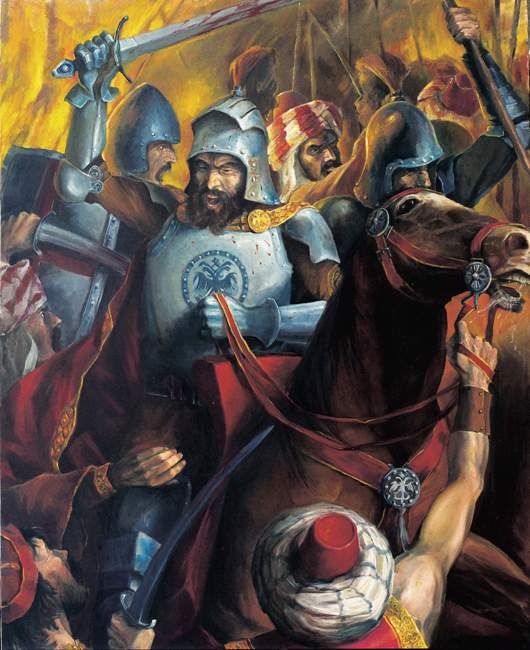
Battle of Plocnik (1386)
Lazar's Bosnian ally,
Tvrtko I, defeated the Turks when they probed Bosnian territory (1386 and 1388).
All this, however, made the Turks only more resolute, and as the year 1389 came,
they were ready. The Eastern Christians in the Balkans were now faced, not by
scattered Turkish forces, but by a great army. Sultan Murad led his army
straight toward Lazar's capital (Krushevats). There was a bloody Turkish assault
on the fortress at Nish, which the Serbs defended heroically for twenty-five
days. This is where Murad himself had an opportunity to evaluate the morale and
effectiveness of the enemy. When Murad's scouts reported the concentration of a
large Serbian army at Kosovo, he marched immediately to meet it. Thus the Balkan
Christians and the Moslems were locked in a decisive battle, a battle that the
Moslems saw as an opportunity to break the backbone of Serbian resistance.
According to Serbian bards
and tradition, Murad sent the following message to Lazar: "Oh Lazar, thou head
of the Serbians: There was not and never can be one land in the hands of two
masters...No more can two sultans rule here... Come straight to meet me at
Kosovo! The sword will decide for us."
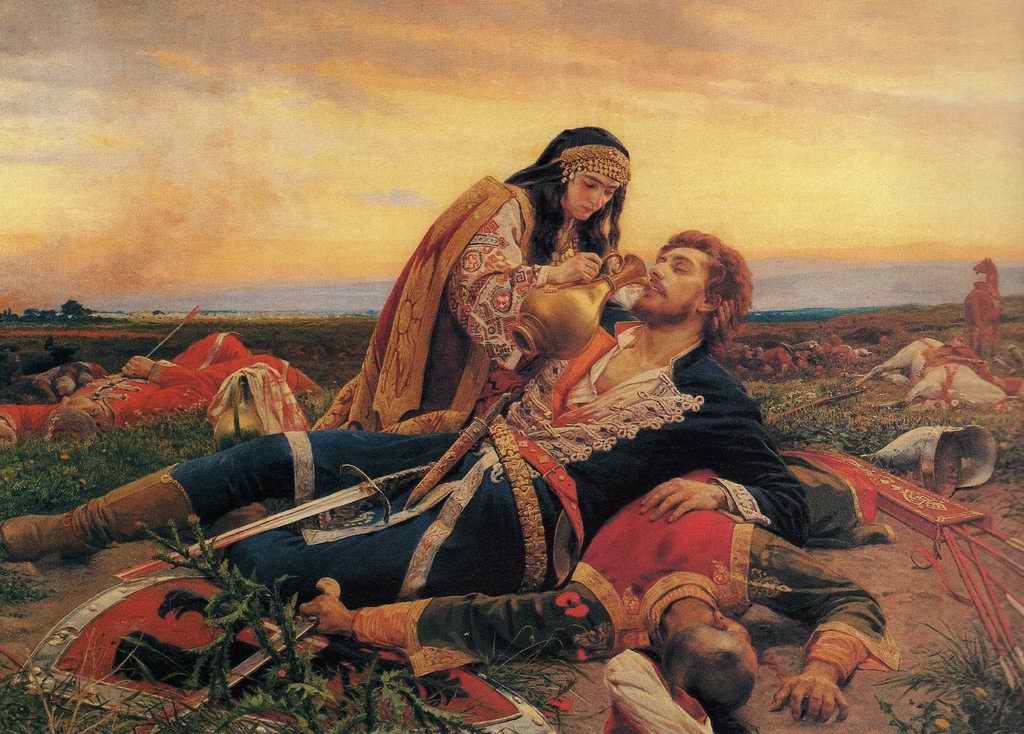
The Kosovo Maiden
Modern historians have had
understandable difficulties in trying to decipher the realities of the battle of
Kosovo. They have had to sift through a myriad of often rhapsodic and idealized,
mostly apologetical, renditions of relevant decisions and events. Contemporary
chroniclers, and later a whole lot of biographers and "history writers," as a
rule had to keep in mind the interests of their protectors and sponsors, with
objectivity not always their trademark. The casual author, for instance, thought
nothing of reviving King Vukashin (eighteen years after his death) and to bring
him to Kosovo as a participant, with "his thirty thousand troops." Groping
through all this poetic license was unavoidable. But to the credit of epic
writers, many of them provided data that were later corroborated by more
reliable sources.
It is quite certain that
Prince Lazar must have held some kind of war council with his vojvodas on the
eve of the battle. Some among those present must have had apprehensions about
Serbian prospects, especially in the light of the hestitancy, lukewarm
enthusiasm, and even disloyalty among some Serbian warriors. Prince Lazar could
easily have agreed with the evaluation which a national bard put into the mouth
of Vuk Brankovich: "Fight we may, but conquer we cannot... " Lazar could also
have believed that some of his vojvodas were seriously thinking of passing over
to the camp of the Sultan, among them Milosh Obilich, who was seen conferring
with two other commanders and inquiring about Turkish battle deployment.
On the eve preceding the
day of the battle, Prince Lazar, according to the Chronicles of Pech and
Tronosha, and later the Chronicle of Monk Pahomie, asked for a golden goblet of
wine to be brought to him. In his toast he mentioned three brave and dashing
vojvodas as possible traitors, who were "thinking of deserting me and going over
to the Turkish side." These three were Ivan Kosanchich, Milan of Toplitsa, and
Milosh Obilich. Prince Lazar appealed to Milosh not to betray him, and drank a
toast to him: "Do not be faithless, and take this golden cup from me as a
souvenir." Milosh responded with a few words of noble indignation: "Oh Tsar,
treachery now sits alongside your knee," an allusion that Vuk Brankovich was
responsible for this lack of confidence. This scene on the eve of the battle
reminds one very much of the Christian saga of the Last Supper, where Lazar
emerges as a person similar to Christ, knows very well the inevitability of
treachery among humans as well as knowing his own fate. Lazar behaved as a good
Christian should, and had no rancor even toward those who failed him. As for
Milosh, he too behaved as a gallant Christian: "For thy goblet I thank you. For
thy speech, Tsar Lazar, I thank you not... Tomorrow, in the battle of Kosovo, I
will perish fighting for the Christian faith."
It is indeed interesting
that the Romanized West never saw Lazar and Milosh, and their likes of Serbian
Orthodoxy, as fighters for Christianity. It is well to recall, however, that
before going into battle, Lazar left the Serbian people the famous statement,
which they have eternally treasured and which is the essence of the Gospel
Message: "The earthly kingdom is short-lived, but the Heavenly One is forever."
As for the Kosovo Battle,
all available information seems to confirm that Murad succeeded in surprising
the Serbian army, as he had done at Maritsa in 1371. In accordance with the
advice of his commander Evrenos Bey (of Greek origin), he launched his attack
early in the morning while Lazar and his comrades were at prayers in the nearby
Samodrezha Church. It was there that news reached him that the enemy was already
attacking his front lines. It was there, also, that he was informed that Milosh
and his two Godbrothers, Ivan and Milan, had been seen riding out in the early
dawn toward the Turkish lines. This must have strengthened his belief that the
three Vojvodas were indeed traitors, and that Vuk Brankovich was right when he
expressed doubts about Milosh. He must have thought of the summons he had sent
to all Serbs before the battle, which according to national tradition reads:
"Whoever born of Serbian blood or kin comes not to fight the Turks at Kosovo, to
him never son or daughter born, no child to heir his land or bear his name. For
him no grape grow red, no corn grow white, in his hand nothing prosper. May he
live alone, unloved, and die unmourned, alone!"
As Lazar blessed his
soldiers, he led them into battle, the clash that was to decide the fate of
Balkan Eastern Orthodox nations for a long period to come. The Turkish historian
Neshri describes the first phase of the battle in the following words:
The archers of the faithful shot their arrows from
both sides. Numerous Serbians stood as if they were mountains of iron. When the
rain of arrows was a little too sharp for them, they began to move, and it
seemed as if the waves of the Black Sea were making noise ... Suddenly the
infidels stormed against the archers of the left wing, attacked them in the
front, and, having divided their ranks, pushed them back. The infidels destroyed
also the regiment... that stood behind the left wing... Thus the Serbians pushed
back the whole left wing, and when the confounding news of this disaster was
spread among the Turks they became very low-spirited... Bayazet, with the right
wing, was as little moved as the mountain on the right of his position (Kopaonik).
But he saw that very little was wanting to lose the Sultan's whole army.
But the quick thinking and
decisiveness of the Sultan's son turned the flow of the battle. Among the Turks
he was known as "Ildarin" (Lightning). He attacked the flank of the advancing
Serbian force, and succeeded in repulsing and throwing into considerable
disarray the hitherto victorious Christians. At that critical moment, a Serbian
corps of some 12,000 cuirassiers was withdrawn from the battle by their
commander, Vuk Brankovich. He apparently either lost his nerve or thought it
inadvisable to lose all of his men in a futile battle. But Lazar was of a
different disposition. He was resolute to fight to the end, and the end soon
came. He tried to rally his disheartened troops around him, and led them into a
new attack, which failed. Inevitably, the morale of the Serbs plummeted.
Wounded, Lazar was taken prisoner, and his army, rapidly falling apart, was
beaten and dispersed on the early afternoon of that very day.
Serbian chroniclers
maintain that, as he was led to Murad's tent, Lazar saw the wounded Vojvoda
Milosh there, and only then realized what a heroic deed he had done. Deeply
touched, Lazar gave Milosh his blessing, as he realized that Milosh had mortally
wounded the Sultan, striking him in the abdomen with a concealed dagger.
Milosh
got access to Murad's tent by pretending he had come to surrender and wanted to
kiss the Sultan's foot.
There they were, in that
tent all the featured actors of the Kosovo drama, ready for the final
Shakesperian resolution of the plot. One of Murad's close advisers (All Pasha)
lay dead already; he too a victim of Milosh's dagger. Prince Bayazet ordered
Lazar and his nobles executed by the sword, in the presence of the dying Sultan.
The Serbian nobles asked to be beheaded first. Bayazet turned down their plea.
But when one of Lazar's vojvodas, Krajimir of Toplista, asked for permission to
hold his own robe so that Lazar's head would not fall to the bare ground,
Bayazet, impressed by such loyalty, granted the request. Milosh Obilich was
beheaded first. As Lazar started to say a few last words to his nobles, he was
abruptly stopped by the Turks. Kneeling, he could only utter: "My God, receive
my soul."
Murad lived long enough to
see his enemies beheaded. As he died, his younger son Bayazet made sure
immediately to eliminate his brother Jacub, who had also taken part in the
battle, and thus assure his ascendance to the highest position as head of the
victorious Turks. Moreover, he took Lazar's daughter Olivera into his harem, and
led the Turks in other battles. The Serbian princess must have meant a lot to
the Turk called Lightning, because when thirteen years later he was taken
prisoner by the leader of the Tartars (Tamerlane), Bayazet chose poison rather
than watch the jewel of his harem, Olivera, serve her new master.
As Vidovdan 1389 came to a
close, and the sun went down behind the mountains of Zeta (Montenegro) in thc
west the night that would last five centuries began. Two tsars, both in their
sixties, lay dead on the plain of Kosovo surrounded by their slain brave
warriors. Murad's body was carried by his warriors all the way to Asia Minor, to
the city of Broussa. Present at the burial ceremony were two Serbian Vojvodas,
the ones that were ordered by Bayazct to escort the body of their enemy. Today,
the visiting tourist is told that the two sarcophaguses, next to Murad's contain
the "bodies of unknown decapitated Serbian nobles."
By the grace of the new
Turkish Sultan, the Serbs were allowed to pick up the severed head of their
leader, and carry it together with the body to the Church of Vaznesenje Hristovo
in Prishtina. Later the remains were moved to the Monastery Ravanitsa, which
Lazar had built. The Serbian Church proclaimed Prince Lazar a saint and holy
martyr. The mutilated body of the Saint Prince could not however, rest long in
his native land. As the Turks moved to the north, his remains were carried to
Frushka Gora (Vrdnik Monastery) in Srem, at that time in Hungary. The wandering
bones had to be moved a fourth time, when in 1941 the Croatian Ustashi began
pillaging Serbian holy places in the newly created Axis satellite, Independent
State of Croatia. Tsar Lazar's relics were taken to Belgrade and now rest in
front of the altar of the main Orthodox Cathedral. New generations can view and
honor Lazar's shrunken body in the robe of faded red and gold brocade, a dark
cloth hiding his head and the gap between it and his shoulders.
For the Serbs, Kosovo
became a symbol of steadfast courage and sacrifice for honor, much as the Alamo
for Americans--only Kosovo was the Alamo writ large, where Serbs lost their
whole nation, but in the words of Sam Houston, it would be "remembered" and
avenged.
 |
 |
 |
 |
 |
 |